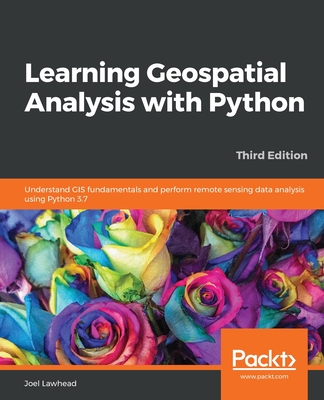Hands-On Geospatial Analysis with R and QGIS: A beginner's guide to manipulating, managing, and analyzing spatial data using R and QGIS 3.2.2
暫譯: 實作地理空間分析:使用 R 和 QGIS 3.2.2 操作、管理及分析空間數據的初學者指南
Shammunul Islam
- 出版商: Packt Publishing
- 出版日期: 2018-11-30
- 售價: $1,980
- 貴賓價: 9.5 折 $1,881
- 語言: 英文
- 頁數: 354
- 裝訂: Paperback
- ISBN: 1788991672
- ISBN-13: 9781788991674
-
相關分類:
地理資訊系統 Gis
海外代購書籍(需單獨結帳)
商品描述
Practical examples with real-world projects in GIS, Remote sensing, Geospatial data management and Analysis using the R programming language
Key Features
- Understand the basics of R and QGIS to work with GIS and remote sensing data
- Learn to manage, manipulate, and analyze spatial data using R and QGIS
- Apply machine learning algorithms to geospatial data using R and QGIS
Book Description
Managing spatial data has always been challenging and it's getting more complex as the size of data increases. Spatial data is actually big data and you need different tools and techniques to work your way around to model and create different workflows. R and QGIS have powerful features that can make this job easier.
This book is your companion for applying machine learning algorithms on GIS and remote sensing data. You'll start by gaining an understanding of the nature of spatial data and installing R and QGIS. Then, you'll learn how to use different R packages to import, export, and visualize data, before doing the same in QGIS. Screenshots are included to ease your understanding.
Moving on, you'll learn about different aspects of managing and analyzing spatial data, before diving into advanced topics. You'll create powerful data visualizations using ggplot2, ggmap, raster, and other packages of R. You'll learn how to use QGIS 3.2.2 to visualize and manage (create, edit, and format) spatial data. Different types of spatial analysis are also covered using R. Finally, you'll work with landslide data from Bangladesh to create a landslide susceptibility map using different machine learning algorithms.
By reading this book, you'll transition from being a beginner to an intermediate user of GIS and remote sensing data in no time.
What you will learn
- Install R and QGIS
- Get familiar with the basics of R programming and QGIS
- Visualize quantitative and qualitative data to create maps
- Find out the basics of raster data and how to use them in R and QGIS
- Perform geoprocessing tasks and automate them using the graphical modeler of QGIS
- Apply different machine learning algorithms on satellite data for landslide susceptibility mapping and prediction
Who this book is for
This book is great for geographers, environmental scientists, statisticians, and every professional who deals with spatial data. If you want to learn how to handle GIS and remote sensing data, then this book is for you. Basic knowledge of R and QGIS would be helpful but is not necessary.
Table of Contents
- Setting up R and QGIS Environments for Geospatial Tasks
- Fundamentals of GIS Using R and QGIS
- Creating Geospatial Data
- Working with Geospatial Data
- Remote Sensing Using R and QGIS
- Point Pattern Analysis
- Spatial Analysis
- GRASS, Graphical Modelers, and Web Mapping
- Classification of Remote Sensing Images
- Landslide Susceptability Mapping
商品描述(中文翻譯)
**實用範例:使用 R 程式語言進行 GIS、遙感、地理空間數據管理與分析的真實世界專案**
#### 主要特點
- 了解 R 和 QGIS 的基本概念,以便處理 GIS 和遙感數據
- 學習使用 R 和 QGIS 管理、操作和分析空間數據
- 應用機器學習演算法於地理空間數據,使用 R 和 QGIS
#### 書籍描述
管理空間數據一直是一項挑戰,隨著數據量的增加,這一挑戰變得更加複雜。空間數據實際上是大數據,您需要不同的工具和技術來建模和創建不同的工作流程。R 和 QGIS 擁有強大的功能,可以使這項工作變得更輕鬆。
本書是您在 GIS 和遙感數據上應用機器學習演算法的夥伴。您將首先了解空間數據的性質,並安裝 R 和 QGIS。接著,您將學習如何使用不同的 R 套件來導入、導出和可視化數據,然後在 QGIS 中執行相同的操作。書中包含截圖以幫助您理解。
接下來,您將學習管理和分析空間數據的不同方面,然後深入探討進階主題。您將使用 ggplot2、ggmap、raster 和其他 R 套件創建強大的數據可視化。您將學習如何使用 QGIS 3.2.2 來可視化和管理(創建、編輯和格式化)空間數據。書中還涵蓋了使用 R 進行的不同類型的空間分析。最後,您將使用來自孟加拉的滑坡數據,利用不同的機器學習演算法創建滑坡易感性地圖。
通過閱讀本書,您將迅速從初學者轉變為 GIS 和遙感數據的中級使用者。
#### 您將學到的內容
- 安裝 R 和 QGIS
- 熟悉 R 程式語言和 QGIS 的基本概念
- 可視化定量和定性數據以創建地圖
- 了解光柵數據的基本知識及其在 R 和 QGIS 中的使用
- 執行地理處理任務並使用 QGIS 的圖形模型器自動化這些任務
- 在衛星數據上應用不同的機器學習演算法進行滑坡易感性映射和預測
#### 本書適合誰
本書非常適合地理學家、環境科學家、統計學家以及所有處理空間數據的專業人士。如果您想學習如何處理 GIS 和遙感數據,那麼這本書就是為您而寫的。對 R 和 QGIS 的基本知識會有所幫助,但並非必要。
#### 目錄
1. 設置 R 和 QGIS 環境以進行地理空間任務
2. 使用 R 和 QGIS 的 GIS 基礎
3. 創建地理空間數據
4. 處理地理空間數據
5. 使用 R 和 QGIS 進行遙感
6. 點模式分析
7. 空間分析
8. GRASS、圖形模型器和網頁地圖
9. 遙感影像分類
10. 滑坡易感性映射




















